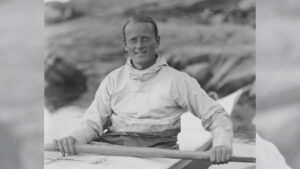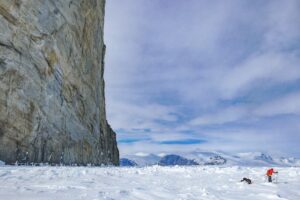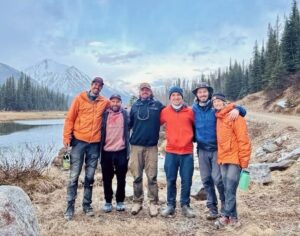Canadian adventure athletes Ray Zahab and Kevin Vallely fly today to extreme northern Canada for an unsupported south-north crossing of Ellesmere Island. They start at Grise Fiord, the Inuit hamlet of 100+ on the south coast, and finish at the military base of Alert on the north coast. The 1,100km ski across Canada’s northernmost island should take 40-50 days.

Grise Fiord, Ellesmere Island: their starting point. Photo: Jerry Kobalenko
Zahab has previously run over 17,000km across the world’s deserts and manhauled on Baffin Island, Lake Baikal, and Antarctica. Vallely is a long-time partner of Zahab. The duo snowshoed in 2009 from Hercules Inlet to the South Pole with Richard Weber. They also teamed up in Siberia.
Zahab’s plan to cross Ellesmere was delayed for a couple of years because of COVID. Non-essential southerners could not travel to the territory of Nunavut during that time. But from his home outside Ottawa, the restless Zahab has continued to train by running, snowshoeing, and cross-country skiing daily.
Vallely, who runs an architecture business, has previously skied Alaska’s 1,860km Iditarod Trail, run Vancouver Island’s West Coast Trail in record time, and retraced a 2,000km Klondike-era ice-bike journey during the Alaskan winter.

Vallely prepares 50 days of food at Zahab’s house. Photo: Ray Zahab
Previous Ellesmere crossings
Two teams have previously skied the length of Ellesmere Island. In 1990, John Dunn led a team of four on a 96-day, 1,250km traverse from Cape Columbia, the northernmost point of Canada, to King Edward Point, the southernmost point of Ellesmere. Dunn and company deposited two supply caches on their flight north. They then skied a route that meandered largely across the ice caps and sea ice of eastern Ellesmere.
Two years later, Canadian Bernard Voyer and two others skied 1,000km from northern Ellesmere to Grise Fiord over 65 days, but they too relied on supply caches.
Note in passing that the northernmost point of Canada has changed since Dunn and company did their trek. At that time, Cape Aldrich, a little to the east, was considered the northernmost point. It now seems clear from newer digital mapping that Cape Columbia is about a kilometre further north than Cape Aldrich. Dunn’s group touched both capes.

The route of the 1990 Ellesmere Island Expedition. Photo: John Dunn
Zahab and Vallely are taking a more land-based route than Dunn’s. They will avoid the mountainous east coast, with its ice caps and fiords, in favor of low passes in the western and central part of the island.
Hard snow and headwinds
Their route should provide good hard snow for swift sledding. In the polar regions, wind and cold transform powder snow into a hard surface over which a sled glides without sinking in. However, they are skiing into the prevailing wind. They are also leaving earlier than the previous expeditions, and friction from the cold snow will make pulling sleds harder.

Greely Fiord, Ellesmere Island, along the duo’s route. Photo: Jerry Kobalenko
For the first two weeks, a film crew, including arctic traveler Caroline Cote and Grise Fiord outfitter Terry Noah, will follow the two Canadians. The crew will then turn back to town. In keeping with the expedition’s self-contained status, Zahab and Vallely will not receive any support from the film crew or resupply along the way.

The approximately 1,100km route from Grise Fjord in the south to Alert in the north. Image: Ray Zahab
Rather than a more common fiberglass or carbon/Kevlar pulk, the pair will use a custom-made ultralight polyethylene sled. They will haul around 80-85kg each, including large portable power stations to keep their camera gear and communication devices topped up.
Polar bear precautions
Although polar bears encounters are always possible in the far north, much of their route is inland, where an encounter is less likely. Nonetheless, Zahab and Valley will carry the usual precautions — a bear alarm fence and firearms.
Traveling mostly on skis, and on foot when hard snow allows, the pair will aim to lay down a reasonable 30km per day.

Zahab with a smaller version of his lightweight custom sled, on Baffin Island. Photo: Natalia Gubareva






